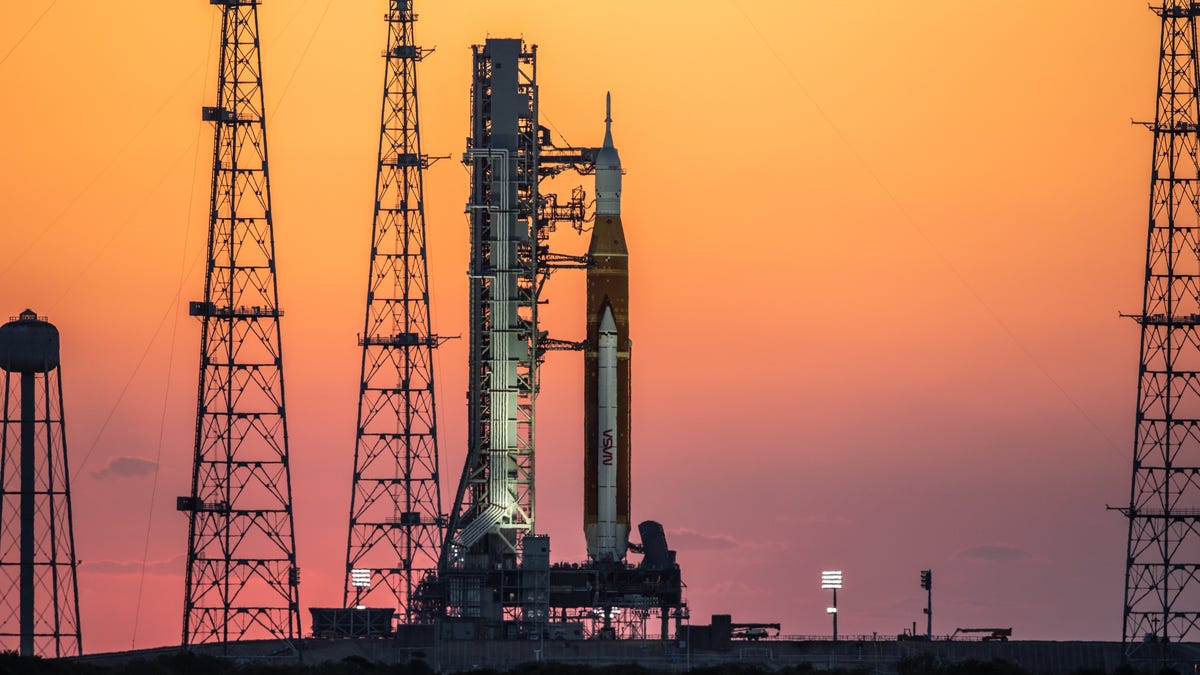NASA Artemis I Moon Mission Slips to Possible August Launch Date
The wet dress rehearsal has been a roller coaster, but the agency doesn't appear to be worried. Here's everything that led up to Artemis I's most recent delay.

A rosy sunrise lightens the sky behind NASA's Artemis I SLS rocket in Florida. Note the NASA "worm" logo in red.
Over the last month or so, NASA has battled sudden, unexpected technical issues surrounding the Artemis I moon mission, a trailblazing endeavor to bring humanity back to the lunar surface. And on Thursday, the agency announced that Artemis I's launch will probably be pushed to August, well after the previous projection of May. That's because important prelaunch testing, NASA says, can likely resume only sometime in the middle of June.
Here's a timeline of the roller-coaster ride leading up to the mission's most recent, rather sizable delay.
Since April 1, NASA has been trying to get through a crucial testing sequence called the "wet dress rehearsal." This is pretty much the final challenge before launch and its name comes from the fact that it's focused on steps like loading the Space Launch System rocket with cryogenic fuel. The wet dress rehearsal for Artemis I has proved to be anything but straightforward.
First, Mother Nature herself delayed the process when four lightning strikes hit within the perimeter of Artemis I's launchpad at NASA's Kennedy Space Center. The agency decided to give the rehearsal another go on April 3 but was soon dealing with safety concerns regarding the SLS rocket's mobile launcher. Basically, the team had trouble pressurizing the launcher well enough to keep harmful gases from entering. At the time, the agency announced it would complete the wet dress rehearsal on April 4, which brought yet another setback.
This time, the issue was with a vent valve, or a panel on the mobile launcher that's meant to relieve pressure from the rocket's core stage. The team was able to isolate the cause of concern.
"After inspection, we found that the manual hand valve was in the closed position and should have been open," Charlie Blackwell-Thompson, NASA's Artemis launch director, said during an early April press conference. Blackwell-Thompson said that one of two primary test objectives had been completed, and three of five secondary objectives, too. One of the leftover secondary objectives was partially done and the other remained totally open.
After that, the agency first expected to resume dress rehearsal operations somewhere between April 8 and April 10, but it later changed the date to April 12. Things had been in a bit of limbo for a while after, but eventually, on April 25, as a result of all the untimely obstacles, NASA decided to totally move Artemis I off the launchpad and back into the Vehicle Assembly Building for a closer examination.
Back to the drawing board.
Returning to the present, on May 5, the agency officially announced that testing likely wouldn't continue until sometime in mid-June. Despite these blips, however, Blackwell-Thompson emphasized that at the end of the day, "this is a test and the purpose of the test is to fully understand our systems."
"I think NASA does some of its best work when it's solving problems, because I think that's part of what calls us to this," Blackwell-Thompson said. "It's that curiosity. It's that love of exploration. But it's also the fact that you have these things you're going to meet head-on and you're going to go solve."
It's a sentiment that echoes the purpose of Artemis I in the first place: to remind the world that Earth's glowing companion is filled with wonder, but also ensure we get things right every step of the way. Future Artemis missions will send astronauts to regions on the lunar surface that are untouched by humans, and simultaneously pave the way for a modern space program by landing the first woman and first person of color on the moon.

